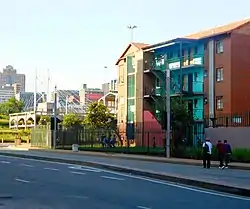Newtown | |
|---|---|
 Newtown, with Nelson Mandela Bridge in the background | |
| Coordinates: 26°12′14″S 28°02′02″E / 26.204°S 28.034°E / -26.204; 28.034 | |
| Country | South Africa |
| Province | Gauteng |
| Municipality | City of Johannesburg |
| Main Place | Johannesburg |
| Government | |
| • Councillor | Nokuthula Albertina Xaba (African National Congress) |
| Area | |
| • Total | 0.85 km2 (0.33 sq mi) |
| Population (2011)[2] | |
| • Total | 2,505 |
| • Density | 2,900/km2 (7,600/sq mi) |
| Racial makeup (2011) | |
| • Black African | 90.0% |
| • Coloured | 1.9% |
| • Indian/Asian | 6.4% |
| • White | 1.2% |
| • Other | 0.6% |
| Language (2011) | |
| • Zulu | 20.9% |
| • English | 12.5% |
| • Tswana | 10.0% |
| • Northern Sotho | 8.1% |
| • Other | 48.6% |
| Website | www |
Newtown is a suburb of Johannesburg, South Africa. It is located in the capital city of Gauteng Province[3] and in Region F of the City of Johannesburg Metropolitan Municipality. It has the coordinates of 26.204°S and 28.034°E. The suburb originated as a manufacturing district for brick production.[4]
Historical background
In the early 20th century, the Newtown Precinct was named "the Brickfields". In 1896, approximately 7,000 people[5] lived in the town.
A number of industries developed at Brickfields, such as trade firms, banks, brick factories, a brewery, and fisheries. Immigrants from other nations, also settled in Brieckfields.[6]
In April 1904, Mahatma Gandi declared an outbreak of the bubonic plague in Brickfield. The plague caused 82 fatalities and 112 people were reportedly diagnosed with it.[7] The local government initiated the fire brigade to start fires within the town, aiming to cease the plague.
Turbine Hall
Originally built between 1927 and 1934, the Turbine Hall became the largest "three steam-driven" power stations. It is situated in the middle of Newtown and has been deemed an iconic building in the art and culture precinct.[8]
Cleanup
The Greater Newtown Construction, was initiated by City of Johannesburg Municipality Council, which rehabilitated old suburb structures, enhanced public open spaces, and introduced closed-circuit television.[9]
Newtown's street lighting was designed by the French engineer Patrick Rimoux.[10]
Regeneration
Johannesburg City Council partnered with Gauteng Agency, Blue IQ, in a project to develop the community of Newtown.[11] The project included building five housing developments in which Council states "[it will] cater for different levels of income".[12]
The plan details that over 2,000 housing units will be built, within the next few years. The Nelson Mandela Bridge which was inaugurated on 20 July 2003,[13] is the northern entrance to Newtown.
References
- ↑ "LGE 2016 List of Councillors". Electoral Commission of South Africa. August 2016.
- 1 2 3 Newport, Statistics South Africa, 2011, retrieved 4 June 2019
- ↑ Mudzamatira, Witness (2019). "The Efficacy of Cultural Resources Management in Southern Gauteng Province, South Africa". The South African Archaeological Bulletin. 74 (209): 3–15. JSTOR 26841984.
- ↑ "Newtown Improvement District - History". www.newtown.co.za. Retrieved 2021-04-09.
- ↑ "Region F Suburbs". www.joburg.org.za. Retrieved 2021-04-09.
- ↑ Herbst, Michael (1998). "Second Johannesburg Biennale: Alternating Currents". African Arts. 31 (3): 74. doi:10.2307/3337580. JSTOR 3337580.
- ↑ Mitchell, J. Alexander (1921). "Plague in South Africa: Perpetuation and Spread of Infection by Wild Rodents". The Journal of Hygiene. 20 (4): 377–382. doi:10.1017/s0022172400034112. ISSN 0022-1724. JSTOR 3859059. PMC 2207056. PMID 20474748.
- ↑ Gaugle (2005). "Alternating Currents of Power: From Colonial to Post-apartheid Spatial Patterns in Newtown, Johannesburg". Urban Studies. 42 (13): 2335–2361. doi:10.1080/00420980500379453. JSTOR 43084426. S2CID 154869892..
- ↑ "Newtown Improvement District - History". www.newtown.co.za. Retrieved 2021-04-04.
- ↑ Dirsuweit, Teresa (1999-06-01). "From fortress city to creative city". Urban Forum. 10 (2): 183–213. doi:10.1007/BF03036618. ISSN 1874-6330. S2CID 154503763.
- ↑ "Development Planning". www.joburg.org.za. Retrieved 2021-04-04.
- ↑ ROGERSON, Christian M.; ROGERSON, Jayne M. (2016). "Intra-urban spatial differentiation of tourism:: Evidence from Johannesburg, South Africa". Urbani Izziv. 27 (2): 125–137. ISSN 0353-6483. JSTOR 24921001.
- ↑ "Steel offers numerous advantages in bridge construction, says SAISC". Leading Architecture & Design. 2019-05-27. Retrieved 2021-04-04.
Seat: Johannesburg | |||||||||||||||||||||||||||||||||||||||||||
| Topics |
| ||||||||||||||||||||||||||||||||||||||||||
| Suburbs |
| ||||||||||||||||||||||||||||||||||||||||||